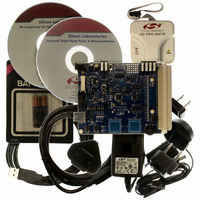C8051F930DK Silicon Laboratories Inc, C8051F930DK Datasheet - Page 204

C8051F930DK
Manufacturer Part Number
C8051F930DK
Description
KIT DEV C8051F920,F921,F930,F931
Manufacturer
Silicon Laboratories Inc
Type
MCUr
Specifications of C8051F930DK
Contents
Target Board, Power Adapter, USB Debug Adapter, Cables, Batteries, and Software
Processor To Be Evaluated
C8051F930
Processor Series
C8051F9xx
Data Bus Width
8 bit
Interface Type
I2C, UART, SPI
Maximum Operating Temperature
+ 85 C
Minimum Operating Temperature
- 40 C
Operating Supply Voltage
0.9 V to 3.6 V
Lead Free Status / RoHS Status
Lead free / RoHS Compliant
For Use With/related Products
C8051F920, F921, F930, F931
Lead Free Status / Rohs Status
Lead free / RoHS Compliant
Other names
336-1473
Available stocks
Company
Part Number
Manufacturer
Quantity
Price
Company:
Part Number:
C8051F930DK
Manufacturer:
Silicon Labs
Quantity:
135
- Current page: 204 of 324
- Download datasheet (3Mb)
C8051F93x-C8051F92x
20.2.4. Automatic Gain Control (Crystal Mode Only) and SmaRTClock Bias Doubling
Automatic Gain Control allows the SmaRTClock oscillator to trim the oscillation amplitude of a crystal in
order to achieve the lowest possible power consumption. Automatic Gain Control automatically detects
when the oscillation amplitude has reached a point where it safe to reduce the drive current, therefore, it
may be enabled during crystal startup. It is recommended to enable Automatic Gain Control in most
systems which use the SmaRTClock oscillator in Crystal Mode. The following are recommended crystal
specifications and operating conditions when Automatic Gain Control is enabled:
•
•
•
•
When using Automatic Gain Control, it is recommended to perform an oscillation robustness test to ensure
that the chosen crystal will oscillate under the worst case condition to which the system will be exposed.
The worst case condition that should result in the least robust oscillation is at the following system
conditions: lowest temperature, highest supply voltage, highest ESR, highest load capacitance, and lowest
bias current (AGC enabled, Bias Double Disabled).
To perform the oscillation robustness test, the SmaRTClock oscillator should be enabled and selected as
the system clock source. Next, the SYSCLK signal should be routed to a port pin configured as a push-pull
digital output. The positive duty cycle of the output clock can be used as an indicator of oscillation
robustness. As shown in Figure 20.2, duty cycles less than 55% indicate a robust oscillation. As the duty
cycle approaches 60%, oscillation becomes less reliable and the risk of clock failure increases. Increasing
the bias current (by disabling AGC) will always improve oscillation robustness and will reduce the output
clock’s duty cycle. This test should be performed at the worst case system conditions, as results at very
low temperatures or high supply voltage will vary from results taken at room temperature or low supply
voltage.
As an alternative to performing the oscillation robustness test, Automatic Gain Control may be disabled at
the cost of increased power consumption (approximately 200 nA). Disabling Automatic Gain Control will
provide the crystal oscillator with higher immunity against external factors which may lead to clock failure.
Automatic Gain Control must be disabled if using the SmaRTClock oscillator in self-oscillate mode.
204
ESR < 50 k
Load Capacitance < 10 pF
Supply Voltage < 3.0 V
Temperature > –20 °C
Figure 20.2. Interpreting Oscillation Robustness (Duty Cycle) Test Results
25%
Safe Operating Zone
55%
Low Risk of Clock
Rev. 1.1
Failure
60%
High Risk of Clock
Failure
Duty Cycle
Related parts for C8051F930DK
Image
Part Number
Description
Manufacturer
Datasheet
Request
R
Part Number:
Description:
SMD/C°/SINGLE-ENDED OUTPUT SILICON OSCILLATOR
Manufacturer:
Silicon Laboratories Inc
Part Number:
Description:
Manufacturer:
Silicon Laboratories Inc
Datasheet:
Part Number:
Description:
N/A N/A/SI4010 AES KEYFOB DEMO WITH LCD RX
Manufacturer:
Silicon Laboratories Inc
Datasheet:
Part Number:
Description:
N/A N/A/SI4010 SIMPLIFIED KEY FOB DEMO WITH LED RX
Manufacturer:
Silicon Laboratories Inc
Datasheet:
Part Number:
Description:
N/A/-40 TO 85 OC/EZLINK MODULE; F930/4432 HIGH BAND (REV E/B1)
Manufacturer:
Silicon Laboratories Inc
Part Number:
Description:
EZLink Module; F930/4432 Low Band (rev e/B1)
Manufacturer:
Silicon Laboratories Inc
Part Number:
Description:
I°/4460 10 DBM RADIO TEST CARD 434 MHZ
Manufacturer:
Silicon Laboratories Inc
Part Number:
Description:
I°/4461 14 DBM RADIO TEST CARD 868 MHZ
Manufacturer:
Silicon Laboratories Inc
Part Number:
Description:
I°/4463 20 DBM RFSWITCH RADIO TEST CARD 460 MHZ
Manufacturer:
Silicon Laboratories Inc
Part Number:
Description:
I°/4463 20 DBM RADIO TEST CARD 868 MHZ
Manufacturer:
Silicon Laboratories Inc
Part Number:
Description:
I°/4463 27 DBM RADIO TEST CARD 868 MHZ
Manufacturer:
Silicon Laboratories Inc
Part Number:
Description:
I°/4463 SKYWORKS 30 DBM RADIO TEST CARD 915 MHZ
Manufacturer:
Silicon Laboratories Inc
Part Number:
Description:
N/A N/A/-40 TO 85 OC/4463 RFMD 30 DBM RADIO TEST CARD 915 MHZ
Manufacturer:
Silicon Laboratories Inc
Part Number:
Description:
I°/4463 20 DBM RADIO TEST CARD 169 MHZ
Manufacturer:
Silicon Laboratories Inc











